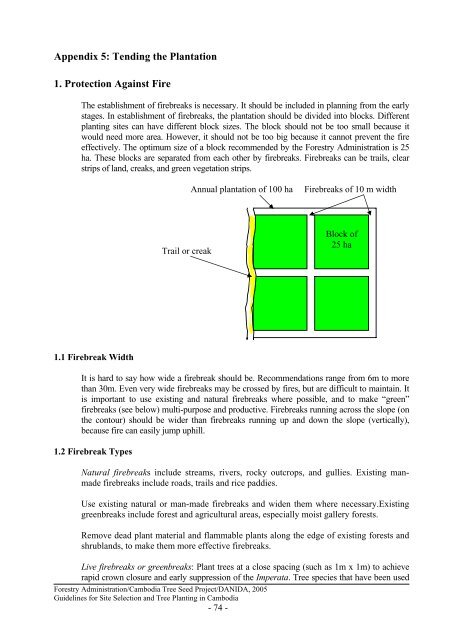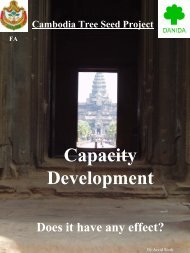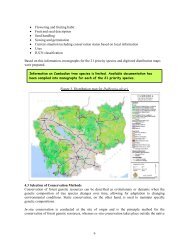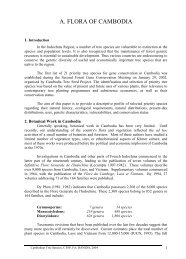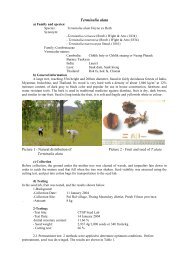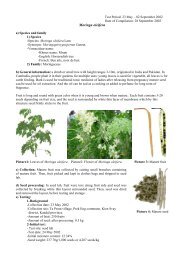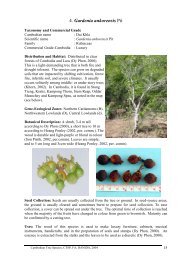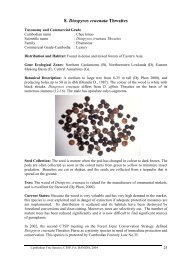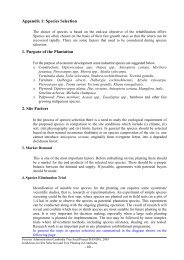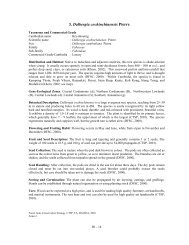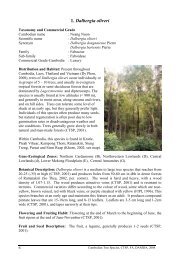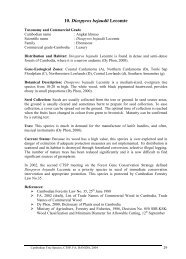Tending the Plantation - Cambodia Tree Seed Project
Tending the Plantation - Cambodia Tree Seed Project
Tending the Plantation - Cambodia Tree Seed Project
Create successful ePaper yourself
Turn your PDF publications into a flip-book with our unique Google optimized e-Paper software.
Appendix 5: <strong>Tending</strong> <strong>the</strong> <strong>Plantation</strong><br />
1. Protection Against Fire<br />
The establishment of firebreaks is necessary. It should be included in planning from <strong>the</strong> early<br />
stages. In establishment of firebreaks, <strong>the</strong> plantation should be divided into blocks. Different<br />
planting sites can have different block sizes. The block should not be too small because it<br />
would need more area. However, it should not be too big because it cannot prevent <strong>the</strong> fire<br />
effectively. The optimum size of a block recommended by <strong>the</strong> Forestry Administration is 25<br />
ha. These blocks are separated from each o<strong>the</strong>r by firebreaks. Firebreaks can be trails, clear<br />
strips of land, creaks, and green vegetation strips.<br />
Annual plantation of 100 ha<br />
Firebreaks of 10 m width<br />
Trail or creak<br />
Block of<br />
25 ha<br />
1.1 Firebreak Width<br />
It is hard to say how wide a firebreak should be. Recommendations range from 6m to more<br />
than 30m. Even very wide firebreaks may be crossed by fires, but are difficult to maintain. It<br />
is important to use existing and natural firebreaks where possible, and to make “green”<br />
firebreaks (see below) multi-purpose and productive. Firebreaks running across <strong>the</strong> slope (on<br />
<strong>the</strong> contour) should be wider than firebreaks running up and down <strong>the</strong> slope (vertically),<br />
because fire can easily jump uphill.<br />
1.2 Firebreak Types<br />
Natural firebreaks include streams, rivers, rocky outcrops, and gullies. Existing manmade<br />
firebreaks include roads, trails and rice paddies.<br />
Use existing natural or man-made firebreaks and widen <strong>the</strong>m where necessary.Existing<br />
greenbreaks include forest and agricultural areas, especially moist gallery forests.<br />
Remove dead plant material and flammable plants along <strong>the</strong> edge of existing forests and<br />
shrublands, to make <strong>the</strong>m more effective firebreaks.<br />
Live firebreaks or greenbreaks: Plant trees at a close spacing (such as 1m x 1m) to achieve<br />
rapid crown closure and early suppression of <strong>the</strong> Imperata. <strong>Tree</strong> species that have been used<br />
Forestry Administration/<strong>Cambodia</strong> <strong>Tree</strong> <strong>Seed</strong> <strong>Project</strong>/DANIDA, 2005<br />
Guidelines for Site Selection and <strong>Tree</strong> Planting in <strong>Cambodia</strong><br />
- 74 -
as live firebreak plantations include Leucaena leucocephala (kathom<strong>the</strong>t), Schima<br />
wallichii(Phaong), Syzygium cumini(Pring), and Vitex pubescens (Popoul).<br />
Clearing for<br />
fire break<br />
Clearing for<br />
fire break<br />
Source: Kathleen et al, 1999.<br />
Multipurpose firebreaks. Incorporate food or wood production in firebreaks where possible.<br />
Clean firebreaks are areas where vegetation has been completely removed by slashing or<br />
cultivation. This approach is not recommended for a permanent firebreak because it<br />
requires much labour, and is unproductive.<br />
Slash or cultivate Imperata again before <strong>the</strong> regrowth begins to dry or turn brown (before<br />
it becomes flammable).<br />
2. Weeding *<br />
Weed control in <strong>the</strong> plantation involves two operations: suppression of weeds, which<br />
means to cut down <strong>the</strong> weeds from <strong>the</strong> planted saplings; and weed elimination which<br />
requires removals of weeds along with <strong>the</strong>ir roots. Weeding should be done within a<br />
radius of 1 m around <strong>the</strong> seedling. Target those weeds that smo<strong>the</strong>r or damage seedlings.<br />
O<strong>the</strong>r growth should be considered harmless and be retained for microclimatic reasons.<br />
Weeds may be controlled by <strong>the</strong> following methods:<br />
2.1 Mechanical Method (weeding by hand or using simple tools)<br />
Where labour is inexpensive and easily available; weeds can be removed by hand. Weeds<br />
can also be cut off or slashed with a knife, sickle, or long machete, at ground level. Many<br />
farmers prefer to dig weeds out of <strong>the</strong> soil using a hoe. This method can be carried out by<br />
cutting of weeds in strips.<br />
2.2 Biological Method<br />
The use of suitable cover crops, maintenance of proper stand density, use of suitable<br />
degree of grazing and use of insect pests which may feed on weeds should be tried in<br />
<strong>the</strong>ir eradication.<br />
(*):This element was extracted and modified from Forestry / Fuelwood Research and Development <strong>Project</strong>.1994.<br />
Forestry Administration/<strong>Cambodia</strong> <strong>Tree</strong> <strong>Seed</strong> <strong>Project</strong>/DANIDA, 2005<br />
Guidelines for Site Selection and <strong>Tree</strong> Planting in <strong>Cambodia</strong><br />
- 75 -
2.3 Frequency of Weeding<br />
Weeds should be removed before <strong>the</strong>y flower and shed <strong>the</strong>ir seed. The first 6 to 8 months<br />
after <strong>the</strong> seedlings have been planted are important. During <strong>the</strong> first year of planting,<br />
weeding should be done every 6 months. This weeding regime should continue until <strong>the</strong><br />
tree canopies start to close toge<strong>the</strong>r. Once that happens, <strong>the</strong>ir shade will inhibit <strong>the</strong><br />
growth of most weeds.<br />
3. Soil Working<br />
Soil working improves infiltration rate, removes compaction, improves soil aeration,<br />
reduces water loss from <strong>the</strong> soil, improves soil structure, checks <strong>the</strong> growth of weeds and<br />
improves <strong>the</strong> general hygiene of <strong>the</strong> area. Soil working is useful during <strong>the</strong> initial years of<br />
plantations. It is generally recommended around plants to a radius of about 50 cm. Soil<br />
working can be done manually or mechanically.<br />
4. Mulching<br />
Mulching is becoming more widely used to control weeds. The main idea of mulching is<br />
to prevent sunlight from reaching <strong>the</strong> weeds so that <strong>the</strong>y will not grow. Many types of<br />
material can be used as mulch, including green manure, straw, sawdust, woodchip or<br />
bark. Plastic sheeting or stones can also be used as light and moisture barriers.<br />
The beneficial effect of mulches are: (i) conservation of moisture by decreasing run off<br />
and evaporation, and increasing <strong>the</strong> infiltration rate, (ii) prevention of soil erosion, (iii)<br />
providing <strong>the</strong>rmal insulation, (iv) maintenance of soil structure by reducing <strong>the</strong> effect of<br />
rain drops, (v) increasing microbial population, (vi) improvement of physio-chemical<br />
property of surface soil and (vii) decreasing weed growth. Thus soil mulches keep <strong>the</strong><br />
surface layer of soil cooler, moist and more permeable to water.<br />
5. Fertilizing and Manuring<br />
Fertilizing is not a standard practice in large scale-plantations. For forestry purposes <strong>the</strong><br />
combination of 12:12:12 (this formula indicates nitrogen : phosphorus : potassium<br />
respectively) is recommended. Urea can be given during watering or just before rainfall. In<br />
each case about 10 -20 g of urea should be spread around <strong>the</strong> plant and covered with soil<br />
(Siyag, 1998).<br />
The fertilizer is to be applied individually, not broadcast, in a ring shape at least 30 cm<br />
from <strong>the</strong> stem. Application of fertilizer too close to <strong>the</strong> stem can damage <strong>the</strong> seedlings, or<br />
even kill <strong>the</strong>m. At least two applications are necessary, during <strong>the</strong> wet season.<br />
Manure is always preferable to fertilizer. A well-composted, decomposed mix of cowdung<br />
and litter or farm waste, can be used effectively. Manure should be applied once a year.<br />
Application of chemical fertilizers and manure will no longer be necessary once <strong>the</strong><br />
seedling reaches three years of age.<br />
Forestry Administration/<strong>Cambodia</strong> <strong>Tree</strong> <strong>Seed</strong> <strong>Project</strong>/DANIDA, 2005<br />
Guidelines for Site Selection and <strong>Tree</strong> Planting in <strong>Cambodia</strong><br />
- 76 -
6. Thinning *<br />
Thinning consists of felling individual trees. This method is often used in an immature<br />
stand to improve <strong>the</strong> growth of remaining trees. Thinning is necessary only when <strong>the</strong><br />
trees are grown to produce sawn timber, veneer, or large poles. It is not required if <strong>the</strong><br />
trees are being grown to produce <strong>the</strong> highest possible volume of small-diameter branches<br />
such as for pulpwood.<br />
Thinning usually involves selecting and removing <strong>the</strong> poorest trees. The remaining trees<br />
will grow faster because competition for light, moisture, and soil nutrients will be less.<br />
Thinning helps to (i) improve <strong>the</strong> health of <strong>the</strong> crop by removing dead, dying and<br />
diseased trees; (ii) salvage anticipated losses of <strong>the</strong> merchantable volume; assure <strong>the</strong> best<br />
physical conditions of growth; obtain <strong>the</strong> desired crop; improve stand composition,<br />
regeneration and protection; and improve wood quality. Some methods of thinning are<br />
recommended below:<br />
Row/strip thinning: When labour is scarce or when using mechanized logging<br />
operations, <strong>the</strong> first thinning generally consists of felling every third row, leaving <strong>the</strong><br />
o<strong>the</strong>r two rows completely untouched.<br />
Selection thinning: This consists of removing diseased or pest-infested individual trees,<br />
as well as dead or dying trees. It also involves removing genetically inferior trees and<br />
plants so <strong>the</strong>y will not compete with superior trees.<br />
Mechanical: This can be done with a bulldozer or a tractor pulling a disc harrow in<br />
alternate strips. This method is applied in uniform block plantations of trees.<br />
Stick thinning: This method is sometimes used in natural stands. It consists of walking<br />
through <strong>the</strong> stand carrying a stick of desired length. Wherever <strong>the</strong> stick touches two trees<br />
simultaneously, <strong>the</strong> inferior tree is removed. The spacing that results averages about 1.5<br />
times <strong>the</strong> length of <strong>the</strong> stick. To thin a stand to approximately 3m spacing, use a stick 2m<br />
long.<br />
(*):This element was extracted and modified from Forestry / Fuelwood Research and Development <strong>Project</strong>.1994.<br />
Forestry Administration/<strong>Cambodia</strong> <strong>Tree</strong> <strong>Seed</strong> <strong>Project</strong>/DANIDA, 2005<br />
Guidelines for Site Selection and <strong>Tree</strong> Planting in <strong>Cambodia</strong><br />
- 77 -


